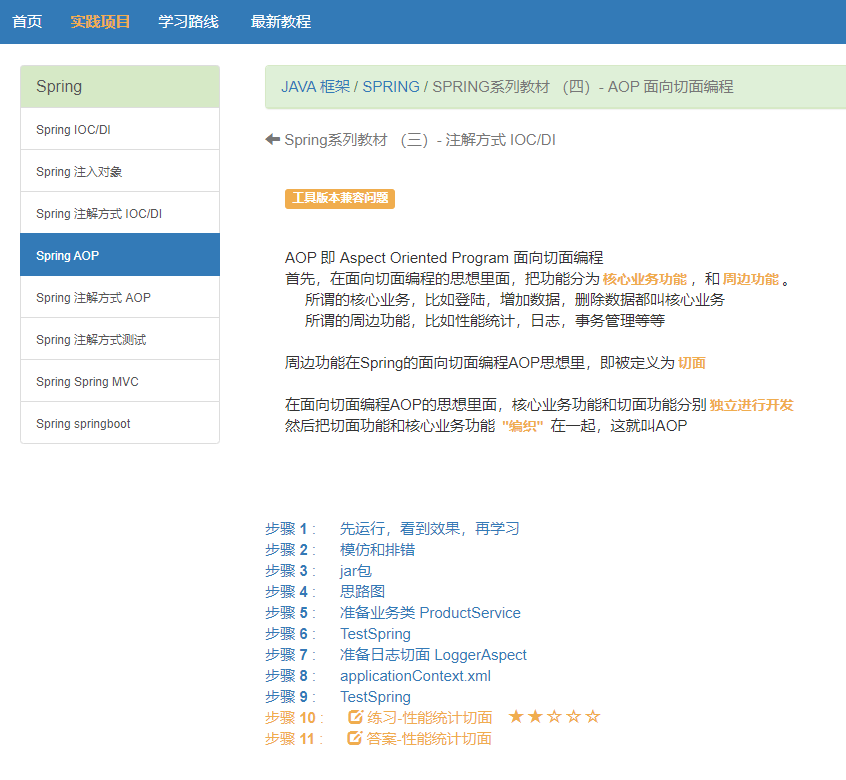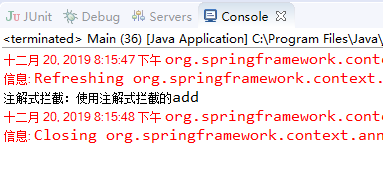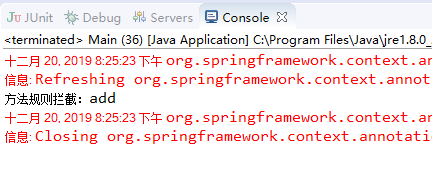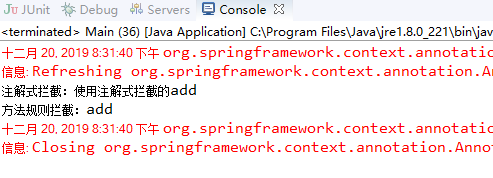02-面向切面AOP
Spring-02面向切面AOP
欢迎大家访问学习:
Spring学习:https://how2j.cn/k/spring/spring-ioc-di/87.html?p=36286
一、介绍
1、面向切面编程,
2、AOP让一组类共享相同的方法。
3、Spring支持AspectJ的注解式切面编程。
二、需求
演示模拟记录日志的操作系统。基于注解拦截和方法规则拦截两种方式。
三、演示
添加pom文件(基于Spirng01之后的添加,可参考前面文章Spring01)
<dependency><groupId>org.springframework</groupId><artifactId>spring-aop</artifactId><version>4.1.6.RELEASE</version></dependency><!-- aspectj支持 --><dependency><groupId>org.aspectj</groupId><artifactId>aspectjrt</artifactId><version>1.8.6</version></dependency><dependency><groupId>org.aspectj</groupId><artifactId>aspectjweaver</artifactId><version>1.8.5</version></dependency>
1、基于注解拦截
a.编写可以用于拦截规则的注解
package com.eleven.aop;import java.lang.annotation.Documented;import java.lang.annotation.ElementType;import java.lang.annotation.Retention;import java.lang.annotation.RetentionPolicy;import java.lang.annotation.Target;/** * 拦截规则的注解 * * @author sywangu * */@Target(ElementType.METHOD) // 表示注解的作用目标,用例修饰字段、方法和类@Retention(RetentionPolicy.RUNTIME) // 表示注解的声明周期@Documented // 该注解表示是否应当被包含在JavaDoc文档中public @interface Action {String name();}
b.编写并使用注解的被拦截类
package com.eleven.aop;import org.springframework.stereotype.Service;@Servicepublic class DemoAnnotationService {@Action(name = "使用注解式拦截的add")public void add() { }}
c.编写切面
package com.eleven.aop;import java.lang.reflect.Method;import org.aspectj.lang.JoinPoint;import org.aspectj.lang.annotation.After;import org.aspectj.lang.annotation.Aspect;import org.aspectj.lang.annotation.Pointcut;import org.aspectj.lang.reflect.MethodSignature;import org.springframework.stereotype.Component;@Aspect // 通过该注解声明一个切面@Component // 该注解表示让这个切面成为Spring管理的一个Beanpublic class LogAspect {// 为了使切点能够多次调用,可以使用PointCue定义一个拦截规则@Pointcut("@annotation(com.eleven.aop.Action)") // 通过该注解声明切点public void annotationPointCut() { }@After("annotationPointCut()") // 使用@PointCut定义的切点public void after(JoinPoint joinPoint) {MethodSignature signature = (MethodSignature) joinPoint.getSignature(); // 方法签名Method method = signature.getMethod(); // 获得签名里面的方法Action action = method.getAnnotation(Action.class); // // 通过反射可以获得注解上的属性,然后做日志记录操作System.out.println("注解式拦截:" + action.name());}}
d.配置类
package com.eleven.aop;import org.springframework.context.annotation.ComponentScan;import org.springframework.context.annotation.Configuration;import org.springframework.context.annotation.EnableAspectJAutoProxy;@Configuration // 声明当前类是一个配置类@ComponentScan("com.eleven.aop") // 自动扫描包下面所有的注解@EnableAspectJAutoProxy // 该注解表示开启Spring对AspectJ的支持public class AopConfig {}
e.运行输出
package com.eleven.aop;import org.springframework.context.annotation.AnnotationConfigApplicationContext;public class Main {public static void main(String[] args) {AnnotationConfigApplicationContext context = new AnnotationConfigApplicationContext(AopConfig.class);DemoAnnotationService demoAnnotationService = context.getBean(DemoAnnotationService.class);demoAnnotationService.add();context.close();}}

2、基于方法规则拦截
可直接在当前项目中编写,下面和上面的是一起的,继续写就行。
a.编写并使用方法规则的被拦截类
package com.eleven.aop;import org.springframework.stereotype.Service;@Service // 声明当前类是Spring管理的一个Beanpublic class DemoMethodService {public void add() { }}
b.编写切面
// 基于方法规则的被拦截类@Before("execution(* com.eleven.aop.DemoMethodService.*(..))")public void before(JoinPoint joinPoint) {MethodSignature signature = (MethodSignature) joinPoint.getSignature(); // 方法签名Method method = signature.getMethod();System.out.println("方法规则拦截:" + method.getName());}
c.运行输出
在Main里面。
// 基于方法规则的拦截DemoMethodService demoMethodService = context.getBean(DemoMethodService.class);demoMethodService.add();

3.完整代码(以上两个合在一起)
a.Action(拦截规则的注解类)
package com.eleven.aop;import java.lang.annotation.Documented;import java.lang.annotation.ElementType;import java.lang.annotation.Retention;import java.lang.annotation.RetentionPolicy;import java.lang.annotation.Target;/** * 拦截规则的注解 * * @author sywangu * */@Target(ElementType.METHOD) // 表示注解的作用目标,用例修饰字段、方法和类@Retention(RetentionPolicy.RUNTIME) // 表示注解的声明周期@Documented // 该注解表示是否应当被包含在JavaDoc文档中public @interface Action {String name();}
b.AopConfig(配置类)
package com.eleven.aop;import org.springframework.context.annotation.ComponentScan;import org.springframework.context.annotation.Configuration;import org.springframework.context.annotation.EnableAspectJAutoProxy;@Configuration // 声明当前类是一个配置类@ComponentScan("com.eleven.aop") // 自动扫描包下面所有的注解@EnableAspectJAutoProxy // 该注解表示开启Spring对AspectJ的支持public class AopConfig {}
c.DemoAnnotationService(注解的被拦截类)
package com.eleven.aop;import org.springframework.stereotype.Service;@Servicepublic class DemoAnnotationService {@Action(name = "使用注解式拦截的add")public void add() { }}
d.DemoMethodService(方法规则的被拦截类)
package com.eleven.aop;import org.springframework.stereotype.Service;@Service // 声明当前类是Spring管理的一个Beanpublic class DemoMethodService {public void add() { }}
e.LogAspect(切面)
package com.eleven.aop;import java.lang.reflect.Method;import org.aspectj.lang.JoinPoint;import org.aspectj.lang.annotation.After;import org.aspectj.lang.annotation.Aspect;import org.aspectj.lang.annotation.Before;import org.aspectj.lang.annotation.Pointcut;import org.aspectj.lang.reflect.MethodSignature;import org.springframework.stereotype.Component;@Aspect // 通过该注解声明一个切面@Component // 该注解表示让这个切面成为Spring管理的一个Beanpublic class LogAspect {// 为了使切点能够多次调用,可以使用PointCue定义一个拦截规则@Pointcut("@annotation(com.eleven.aop.Action)") // 通过该注解声明切点public void annotationPointCut() {}// 基于注解的被拦截方式@After("annotationPointCut()") // 使用@PointCut定义的切点public void after(JoinPoint joinPoint) {MethodSignature signature = (MethodSignature) joinPoint.getSignature(); // 方法签名Method method = signature.getMethod(); // 获得签名里面的方法Action action = method.getAnnotation(Action.class); // // 通过反射可以获得注解上的属性,然后做日志记录操作System.out.println("注解式拦截:" + action.name());}// 基于方法规则的被拦截类@Before("execution(* com.eleven.aop.DemoMethodService.*(..))")public void before(JoinPoint joinPoint) {MethodSignature signature = (MethodSignature) joinPoint.getSignature(); // 方法签名Method method = signature.getMethod();System.out.println("方法规则拦截:" + method.getName());}}
f.Main(运行输出)
package com.eleven.aop;import org.springframework.context.annotation.AnnotationConfigApplicationContext;public class Main {public static void main(String[] args) {AnnotationConfigApplicationContext context = new AnnotationConfigApplicationContext(AopConfig.class);// 基于注解的方式DemoAnnotationService demoAnnotationService = context.getBean(DemoAnnotationService.class);demoAnnotationService.add();// 基于方法规则的拦截DemoMethodService demoMethodService = context.getBean(DemoMethodService.class);demoMethodService.add();context.close();}}




































还没有评论,来说两句吧...